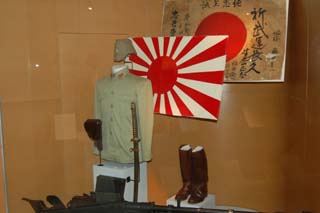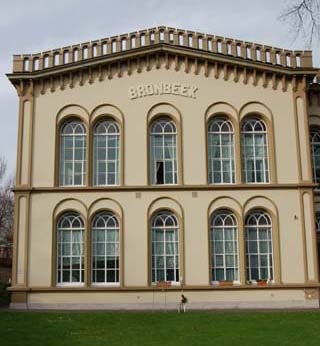Important note
Photos provided on this website are not an endorsement of any political idea or of war. War is one of the most regrettable human activities.
All photos on this page are copyright Robert Mary and may only be reproduced with my express permission. You may contact me here
Historical information


The Dutch capitulation in Java
On 8 December 1941, the day after the Japanese attack on Pearl Harbour,
the Netherlands declared war on Japan. Japanese forces subsequently began
their unstoppable push southwards. The Americans in the Philippines and
the British in Malacca and Singapore were defeated. Then it was the turn
of the Dutch East Indies. An Allied fleet, under the command of Rear-Admiral
Karel Doorman tried in vain to hold back the Japanese invasion fleet
in the Java sea. Parts of the Dutch East Indies had been under fire since
January 1942, but on 1 March the Japanese landed on the coast of Java.
Especially as a result of the Japanese domination in the air, the KNIL
(Royal Netherlands Indies Army) lost most of the battles.
On 9 March 1942, the capitulation was signed at Kalidjati air base. The
Japanese occupation had begun.
Historical background
- The KNIL
On 7 December 1941 Japan attacked the American naval base in the Pacific
ocean, Pearl Harbour. This was the start of WW2 in Asia. Japan, having
all kinds of imperialist plans, was in great need of Raw materials, such
as oil, rubber and copper, the Dutch East Indies were an attractive target
for the Japanese. The Netherlands entered into an alliance with the United
Sates of America, Great Britain and Australia., but they could not halt
the Japanese advance. After the battle in the Java sea, which the Allied
fleet lost, the Japanese forces landed on Java and Sumatra. The KNIL
surrendered after a brief conflict.
The KNIL soldiers had different options:
? Die in the battle (the Military Aviation Branch of the KNIL in particular
distinguished itself in the terrible days following 8 December 1941);
? Capture (the majority of KNIL personnel were captured)
? Leave for a friendly and unoccupied country (a number of Dutch succeeded
in reaching Ceylon (Sri Lanka) or Australia. The fight was continued
from there).
The Beginning of decolonisation
After the atom bombs were
dropped at the beginning of August 1945, Japan surrendered unexpectedly
quickly. In the Dutch East Indies this resulted
in a chaotic period which is called the Bersiap period. Thanks to the
existence of a power vacuum –there were no liberators in sight-
Sukarno took the opportunity to proclaim the foundation of the Republic
of Indonesia. Fanatical young nationalists, who were full of Japanese
and Republican propaganda, wreaked havoc among the Chinese and even attacked
the internment camps. In a few cases the Japanese troops had to protect
the Dutch prisoners against these attacks. These circumstances ensured
that there was no real question of liberation. Six weeks after the Japanese
capitulation, the first British troops arrived. They succeeded in liberating
most of the camps and moving the prisoners. There were hardly any Dutch
troops: most KNIL soldiers were still interned in camps throughout South
East Asia, and the first troops from the Netherlands did not arrive until
autumn of 1945.

The official
website of the museum stands here.
Official Authorities of the museum can be contacted there.
Location information
The museum is located at 147 Verperweg in Arnhem (Holland).
Personal note
The museum is focused
on the Dutch colonial period at large (WW2 being only a part of it).
Museum Bronbeek has an excellent collection of Japanese weapons. A showcase
displays a Japanese pilot, another showcase displays a Japanese officer
uniform with sabre.
The Bronbeek museum is also a Colonial Military convalescent home for
invalid persons of min 65 years old from the rank of officer (such institution
exists since 1859).
(Source: "L'épopée Kamikaze", Bernard Millot - Robert Laffont editions 1970)
Chronological list
of events leading to the myth of Japanese "defensive" war:
a) 1926: Creation of Mandchukuo puppet state
b) 1931: Mandchukupo invaded by Japan
c) 1937: War with China
d) July 1940: USA voted the law to limit the exportation of petrol to
Japan.
e) September 1940: North Indochina occupied by Japan (with approval of
Vichy puppet state)
f) 1939: Molotov-Ribbentrop pact paved the way for Japanese-Soviet pact
of april 1941. Note that the decision to attack USA instead of Soviet
Union was taken with a tiny majority in Tojo War Cabinet (The Imperial
Navy wanting a
coprosperity sphere in Asia, The Army willing to smash the Soviets).
Khalkin Gol border incidents in 1938 against General Zukhov showed that
USSR was not easy to defeat..., this has probably played a role in the
decision
to attack USA.
g) July 1941: Occupation of whole Indochina by Japan ("common defense
of Indochina" by "mutual agreement" with Vichy).
h) As a result USA blocked Japanese assets in the States.
i) August 1941: Konoye Prince tried to force USA to change attitude,
he failed and General Tojo came to power. War was then unavoidable.
j) December 1941: Pearl Harbour was not meant to begin an assault on
US territories, but to inflict such severe losses to the US fleet so
that Japan could have time to create its "sphere of coprosperity" with
a strong defensive perimeter awaiting American reaction. So
Japan lead a pure "defensive" war according to its beliefs even
if the attack at Pearl Harbour is commonly recognized as the beginning
of an agressive war.
The book also mentions some assumptions, some choices that might have
happened just before the Battle of the Coral Sea which halted the Japanese
advance (but not definitely, the Battle of Midway being the confirmation):
a) Attack of the Soviet Union, in Siberia in 1942 on request of Germany
b) Conquest of India (in order to get oil in the Middle East)
c) Conquest of Australia. But in May 1942 after the Battle of the Coral
Sea, expansion in Australia became a abandonned project. The furthest
advance being towards Port Moresby which had never been captured.